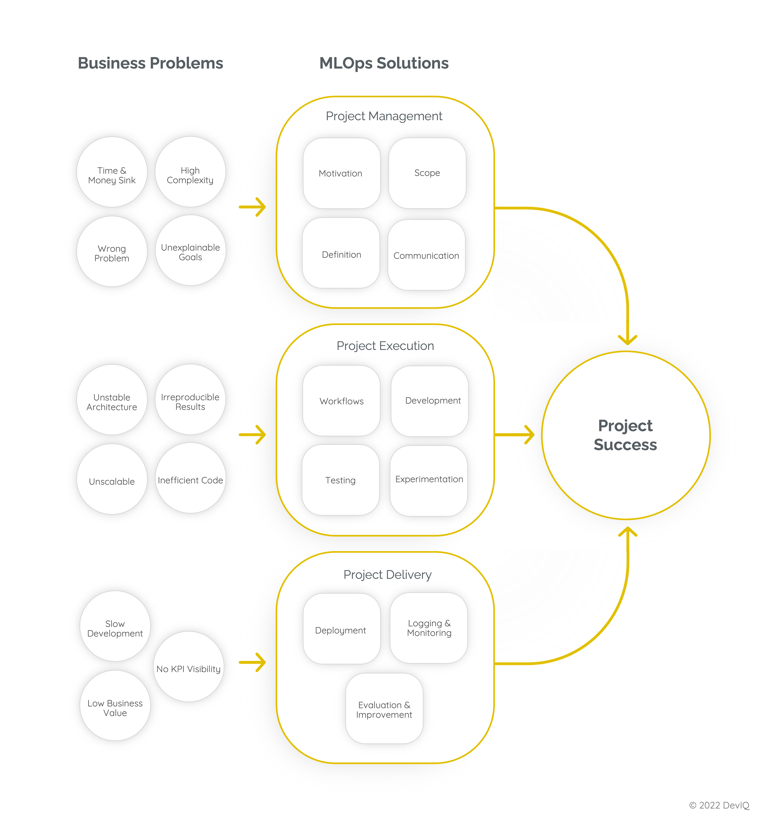Implementing MLOps processes and requirements allows data science projects to overcome common pitfalls in project management, execution, and delivery. It can be the difference between success or failure...
MLOps Definition & Benefits
Machine learning operations (MLOps) are the formal processes and requirements that govern activities within a data science project and facilitate its success. Analogous to development operations (DevOps), MLOps processes include continuous integration, continuous delivery, automation, and collaboration. These standardized processes create the foundation for a project’s machine learning lifecycle, which includes data engineering, data analysis and preprocessing, model development, and model deployment.

Leveraging MLOps with structured management, efficient execution, and prompt delivery in place can:
- Enhance a development team’s workflows.
- Provide robust quality assurance and testing.
- Increase executive’s visibility into key performance indicators (KPIs).
- Deliver high-quality solutions to customers more quickly.
Project Management for MLOps
Data science projects are often plagued by the same ails other technical projects suffer:
- The project does not solve the problem or solved the wrong problem.
- The project is too complex.
- The project takes too long and requires too much money to complete.
- The purpose and goals of the project are not easily explainable.
To overcome these problems, MLOps provides structured project management that motivates the project, defines the problem, scopes the work, and formalizes communication.
Motivation
Sufficient and meaningful motivation sets the course of a project by helping stakeholders and developers understand the correct problem to solve and by linking the problem to one or more strategic goals of a company.
Definition
Subsequently, the problem needs to be properly defined so that a project satisfies its goals without becoming burdened by undue complexity. Problem definition includes researching existing or proposed solutions to the problem, specifying the desired output metrics, available input data, and proper algorithms, and establishing the required development and deployment tools.
Scope
Successful projects have a well-defined scope that characterizes the deliverables and validates the financial and timeline feasibility.
Communication
Finally, formalizing leadership structure, involving subject matter experts, and relaying meaningful updates to stakeholders are necessary communication steps that help ensure a project’s outcomes align with its purpose and goals.
Project Execution for MLOps
Even with successful management, data science projects often fail during the execution phase. Common failure points include:
- The results are not reproducible.
- The code is fragile or inefficient.
- The architecture is inadequate or unstable.
- The solution is not scalable.
MLOps reduces or eliminates these failure points by providing efficient project execution through workflows, development, testing, and experimentation.
Workflows
Workflows are critical to ensure that identical results can be obtained in developing, staging, and production environments. To achieve reproducibility, workflows must validate data before training and prediction steps, automate training jobs, and track experiments.
Development
Development activities within a workflow must utilize tools that support the project definition and scope, create maintainable code, ensure data availability and accuracy, and implement source control to version code, data, and model artifacts; these activities result in robust and efficient code.
Testing
Before deployment to production, testing is required to ensure the solution can operate successfully within a stable architecture. Testing includes comprehensive unit tests, tests for model staleness and correctness, and integration and stress tests on the workflow.
Experimentation
Finally, scalable data science solutions result from utilizing the most accurate and efficient models; experimentation helps to ensure that the workflow can scale for additional data and models by evaluating the existing algorithms, exploring alternative data sources and algorithms, and comparing approaches to ascertain the best overall solution.
Project Delivery for MLOps
The final hurdle to a successful data science project is ensuring that the proper solution is delivered promptly to the customer. Common delivery pitfalls include:
- Slow development, deployment, and updates.
- Little or no KPI visibility.
- The project cost exceeds business value.
MLOps clears this hurdle by demanding prompt project delivery that utilizes deliberate deployment, logging and monitoring, and evaluation and improvement techniques.
Deployment
Successful project delivery necessitates rapid deployments that use simple, scalable methods and platforms, employ continuous integration to run tests, build source code, and develop required deployment artifacts, and provide continuous delivery to deploy pipelines to the target environment.
Logging & Monitoring
After deployment, KPI visibility through logging and monitoring is critical to ensure a solution continues to operate as expected and delivers relevant information to stakeholders. These benefits can be achieved by implementing a model registry that stores trained models, a feature store that provides data features for model training and serving, and a metadata store that includes model names, parameters, training data, test data, and metric results.
Evaluation & Improvement
Finally, evaluation and improvement of the data and algorithms by collecting the correct metrics and validating model performance helps customers have confidence that the results obtained from the solution are current and are providing significant business value.
MLOps vs Failure
MLOps translates the accepted and well-tested processes of DevOps into capabilities that can be leveraged on data science projects. Implementing these processes allows projects to overcome common pitfalls in project management, execution, and delivery by providing distinct requirements at each stage. In summary, using MLOps can be the difference between a project’s success or failure and should be standard operating procedure for all companies that intend on performing data science work.
This article is part of DevIQ's series on MLOps. Continue exploring this topic:
